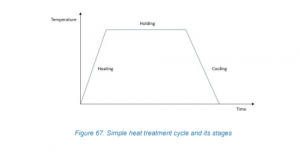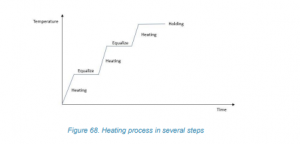Lesson 5: HEAT TREATMENT I – fundamentals of heat treatment
In this lesson, we will delve into the fundamentals of heat treatment, a vital process for altering the properties of metals and alloys.
- Introduction to Heat Treatment
- Heat treatment is a crucial process used to modify the properties of metals and alloys.
- It involves subjecting a workpiece to a specific temperature-time cycle without partial melting.
- Heat treatment can encompass additional effects, such as chemical, mechanical, or other physical changes.
- In industries like machinery, thermal and thermochemical processes are commonly applied, while raw material manufacturers often use thermomechanical rolling processes for fine-grain structures.
- Understanding the Basics
- Common metals and alloys possess a crystalline structure, and their behavior relies on materials science concepts like crystallography and metallurgy.
- The mechanical properties of alloys are determined by their microstructure, which can be equilibrium or nonequilibrium based on cooling conditions.
- The microstructure comprises various phases, including pure metals, solid solutions, and compounds.
- Heat treatment can significantly influence the microstructure through transformations during temperature changes.
- Transformations may include allotropic transformations, eutectoid reactions, solubility limitations, and changes due to plastic cold working.


- Heat Treatment Process
- The heat treatment process consists of three primary steps: heating, holding, and cooling.
- Heating should be performed as rapidly as possible, but it must consider material type, dimensions, and shape to prevent thermal stresses and deformation.
- In critical cases, preheating may be necessary to introduce heat equalization stages.
- Holding is essential to allow desired phase changes, but excessive holding can coarsen the grain structure and deteriorate mechanical properties.
- Cooling is achieved using a cooling medium, with the cooling rate influenced by its quality and flow conditions. The quench severity factor (H) characterizes the cooling medium’s efficiency.
- Time-Temperature-Transformation (TTT) Diagrams
- For developing heat treatment technologies, TTT (time-temperature-transformation) diagrams are used.
- TTT diagrams have a characteristic C-shape and depict phase transitions as a function of temperature and time.
- Isothermal transformation (IT) and continuous cooling transformation (CCT) diagrams are two types of TTT diagrams.
- Isothermal heat treatments occur at constant temperature and are ideal for ensuring uniform microstructures and preventing warpage.
- Continuous cooling is used when sudden cooling isn’t feasible, but it can result in non-uniform microstructures.
- Accurate predictions of heat treatment outcomes can be made using finite element programs, but knowledge of material properties is essential for reliability.
- Surface Modification Heat Treatment
- Heat treatment can also be employed to modify the surface of parts.
- These surface modification heat treatment processes primarily aim to enhance hardness and wear resistance.
Conclusion
- Heat treatment is a critical process for modifying the properties of metals and alloys.
- Understanding the fundamentals of heat treatment, including the phases, transformations, and TTT diagrams, is essential for achieving desired material characteristics.
- Whether for improving mechanical properties or enhancing surface attributes, heat treatment plays a pivotal role in various industries.
In this lesson, you’ve acquired a foundational understanding of heat treatment, a process essential for tailoring the properties of metals and alloys to meet specific requirements. These fundamentals are key to achieving desired material characteristics and ensuring the reliability of heat treatment processes.